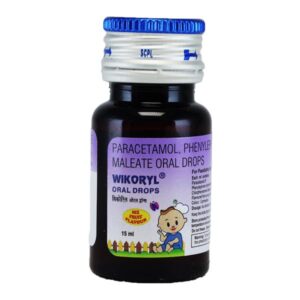PARACETAMOL + PHENIRAMINE + CHLORPHENARAMINE
Paracetamol: Paracetamol, also known as acetaminophen, is a commonly used over-the-counter analgesic and antipyretic medication. It is used to relieve pain and reduce fever in adults and children.
The precise mechanism of action of paracetamol is not fully understood, but it is believed to work by inhibiting the synthesis of prostaglandins in the central nervous system, which helps to reduce pain and fever. Unlike nonsteroidal anti-inflammatory drugs (NSAIDs), paracetamol has limited anti-inflammatory effects.
The recommended dose of paracetamol for adults is usually 500-1000mg every 4-6 hours, with a maximum daily dose of 4g. It is important to follow the dosing instructions on the packaging or as advised by a healthcare professional. For children, the dose is based on weight and age, and it is important to use pediatric formulations and follow the recommended dosage guidelines.
Paracetamol is generally considered safe when used as directed, but it can cause certain side effects. Common side effects include nausea, vomiting, and abdominal pain. In rare cases, it can cause severe allergic reactions, such as skin rash, difficulty breathing, or swelling of the face, lips, or throat. Overdosing on paracetamol can cause liver damage, so it is important to follow the recommended dose and avoid taking multiple medications that contain paracetamol simultaneously.
It is worth noting that paracetamol may interact with certain medications, such as warfarin (a blood thinner), so it is important to inform your doctor or pharmacist about all the medications you are taking before using paracetamol.
Overall, paracetamol is a widely used and effective medication for pain relief and fever reduction, but it is important to use it as directed and be aware of the potential side effects and interactions.
Pheniramine: Pheniramine is an antihistamine drug used to relieve symptoms of allergies such as hay fever, hives, itching, and sneezing. It belongs to the class of drugs known as first-generation antihistamines.
The primary mechanism of action for Pheniramine is its ability to block the effects of histamine, a chemical released during an allergic reaction. By blocking histamine, Pheniramine reduces or eliminates symptoms caused by histamine, such as itching, runny nose, and watery eyes.
Pheniramine is commonly available in oral tablet or liquid form. The recommended dose for adults is usually 25 to 50 mg every 4 to 6 hours, with a maximum daily dose of 150 mg. For children, the dose is based on their weight and is typically lower than the adult dose.
Like most medications, Pheniramine may have some side effects. These can include drowsiness, dry mouth, blurred vision, constipation, and urinary retention. Some individuals may also experience a paradoxical reaction, where they become more excited or agitated instead of sedated.
It is important to note that Pheniramine can interact with other medications such as sedatives, opioids, or alcohol, leading to increased drowsiness or respiratory depression. Therefore, it is crucial to inform your healthcare provider about any other medications you are taking before starting Pheniramine.
Pheniramine should not be used in individuals with certain conditions like glaucoma, urinary retention, or severe liver disease. Additionally, caution should be exercised when using Pheniramine in older adults or individuals with respiratory conditions like asthma or chronic obstructive pulmonary disease (COPD).
As always, it is recommended to consult with a healthcare professional or pharmacist for specific dosing instructions and to discuss any potential risks or concerns before starting any medication, including Pheniramine.
Chlorphenaramine: Chlorpheniramine is an antihistamine drug that is used to relieve allergy symptoms such as hay fever, itchy eyes or nose, sneezing, and hives.
Its mechanism of action involves blocking the effects of histamine, which is a chemical released during an allergic reaction. By blocking histamine, Chlorpheniramine helps to reduce allergy symptoms and provides relief to the affected individual.
Chlorpheniramine is typically available in the form of tablets, capsules, or liquid suspension for oral administration. The recommended dosage for adults is usually 4 milligrams every 4 to 6 hours, with a maximum daily dose of 24 milligrams. However, the specific dosage may vary based on the individual’s age, condition, and response to treatment. It is important to follow the directions provided by the healthcare professional or the instructions on the medication label.
As with any medication, Chlorpheniramine may cause side effects. Common side effects include drowsiness, dizziness, dry mouth, blurred vision, constipation, and urinary retention. These side effects are usually mild and temporary in nature. However, if they persist or worsen, it is important to seek medical attention.
Chlorpheniramine is generally considered safe for most people when used as directed. However, it may not be suitable for individuals with certain medical conditions, such as glaucoma, heart disease, high blood pressure, or urinary tract problems. It is important to inform the healthcare professional about any pre-existing medical conditions or medication allergies before starting Chlorpheniramine.
Additionally, Chlorpheniramine may interact with other medications, such as sedatives, tranquilizers, or other antihistamines, leading to increased drowsiness or other adverse effects. It is important to inform the healthcare professional about all the medications being taken to avoid potential interactions.
Overall, Chlorpheniramine is an effective antihistamine used to relieve allergy symptoms. However, it is important to use it as directed and consult a healthcare professional if any concerns or side effects arise.

